Rehabilitated penguins
Sea-kayak lead guide interview
Ben's interviewWhere are you from and what is your passion? Originally from France I have always had an interest in Nature and Outdoor sports. For me, being outside is the place to be. I love observing animals' behaviours with my binoculars who seem to be following me wherever I go. Birds are my main passion and kayaking is the perfect activity to see animals without disturbance and impact to the environment. Sometimes, you hear crazy stories like a seal smacking a kayaker in the face with an octopus or a seagull colony attacking them. Most of the time when this happens, it is because the kayaker(s) push too much the encounter and came to close. So, of course, you just need to read what Nature tells you. The reason why I also moved and work here, is because I fell in love with Pohatu and the project Shireen and Francis Helps started more than 30 years ago. (to find out more visit Pohatu's trust page).
What does a normal day of work look like? After a good breakfast and checking the forecast apps on my phone - I use mainly Windfinder and Windy - I go to Akaroa to pick up my “early bird(s)” (client(s) on an early sea-kayaking tour) from our office shop and we leave at 8am for Flea Bay. If the wind forecast is a little bit dodgy, I like to call the bay to make sure that it’s possible to go kayaking. I drive everyone with our 9-seater Pohatu mini-van (takes between 25-30 min). Once there the first thing I do is turning on the marine radio for safety. We don’t have cell-phone reception there. After that, I gear up and make sure everyone has the right equipment to enjoy a nice experience. We provide a splash deck, lifejackets and paddle and even waterproof cases for phone or camera. We head to the beach and set up the kayaks we need for the trip, then on the beach for some instructions on safety and lessons of paddling. When I’m confident that everyone is ready and trained, off we go for a fantastic sea kayak trip. We are really lucky to experience something unique. For me this place is one of the best places to have a first sea-kayaking experience and at the same time having the chance to see wildlife without disturbance. Being in a remote place gives you the chance to only hear just Nature; it is really rare to encounter an engine boat. I like to start my tour by checking on my people, asking if everything is alright and if anyone needs more advice. And hop, let’s go for a really pleasant adventure. We have the chance, right at the beginning to see our first birds in the bay and that is a colony of Pied Cormorant (and not Shag). I like to explain the difference between the 2 families of birds. Exceptional swimmers, it’s pretty common to have them around the kayaks. If we have had perfect conditions for more than a week with no waves, we can be lucky to see our first kelp forest and maybe some fish, starfish or seals under the kayaks. Kayaking in the middle of the largest Little Penguin colony on the New Zealand mainland can give you the chance to observe some of these really special birds. The White-Flippered penguins are unique in the world and slightly different than its cousin from Australia and the rest of New Zealand. We can see fledglings sometimes on rocks but most of the time in cracks - I always try to make sure that the bird is healthy enough to survive at least a few days and looks relaxed. It can be juvenile penguins (2-4 years old, really tricky to tell the age of the bird) or adults. When it’s the moulting season, it is important to make sure that they have plenty of fat reserves. It all depends on the time of the year you come here. When I do the afternoon trip, I sometimes even see some adults (swimming in a raft of birds) who are coming from their long journey fishing out at sea. But they have to be careful and alert for a special bird who is more and more common out here: the giant petrels. These birds are nesting over the subantarctic islands and with their large wingspan, they like to come over our coast to look for food. They are called the vulture of the sea. Since I’ve started kayaking in this bay, I have seen an increase in viewing. I used to spot the petrels occasionally now it’s almost every day. Kayaking in the first Marine Reserve on the east coast of the South Island can show you so much wildlife and it brings you so much happiness. Unfortunately, we don’t have a lot of them around the New Zealand coast (only 1%). Since 1999 it's been totally forbidden to go fishing, harvesting shell fish or seaweeds and even picking driftwood here at Pohatu, it’s a total untouched paradise - you can see that Nature is returning and abundant. We also have the chance to encounter a really special dolphin, unique to the coast of New Zealand: the Hector’s Dolphin. When a pod is coming around the kayak(s) it gives you so much joy and you feel thankful for this short time with them. Sometimes they can be really playful and they are also curious and check you out, other times they only pass by but every encounter, short or long is always a fantastic moment. After crossing the bay it’s time to talk about Pinnipeds, with one of the most familiar seals in New Zealand: the New Zealand Fur Seal. Since 2000 the population has been growing pretty well and now the colony is stable and on every trip we see them being lazy or interacting on the rocks or in the water. They’re amazing and sometimes they remind you of your dog you left at home. That’s why, Germans named them sea dogs. We finally cross the bay back and safely land every kayak. We do a big loop around the bay and generally spend an hour to an hour and half gently going around the marine reserve. If I have a trip in the afternoon, we can leave a few or all the kayaks on the beach far enough away from the tide so it doesn’t drag them out. We wash our gear in the small creek we have next to the kayak shed and put everything to dry up. Then off we go back to Akaroa trying to be back around 11:30 for my lunch and before starting a new journey for the afternoon Sea Kayaking at the beautiful Pohatu Marine Reserve.
What was your favourite experience kayaking at Pohatu? First, Flea Bay is worth visiting on its own, it’s a little paradise in New Zealand. After, it’s difficult to say because there have been so many amazing trips since I arrived. Between saving fledgling Little Penguins that are too young and too weak or kayaking around the fantastic Bottlenose Dolphins that came swimming one day in the bay or having a young New Zealand Sea Lion welcoming you back from your trip on the beach. But one trip will be unforgettable for sure. It was a normal morning but the forecast wasn’t the best, a Northwest wind was supposed to come in (it can push us outside the bay, goodbye Flea Bay, hello Antarctica). I said to my clients, we might have to stay on land and talk about penguins if the sea conditions don’t cooperate. They really wanted to go either way, so we drove and I reassessed the wind once at the bay. On the way down one of them spotted some black things in the water. I thought it was seaweed or maybe big fur seal bulls. But it was strange so I took out my binoculars and realised it was a pod of Orcas. An Alpha male, a female with a really young one at her side and 3 others maybe a bit younger. I went in 2014 to Canada to have the chance to see them via sea kayak, but I always wanted to also have the chance to kayak with them here. When we arrived at the bay, the wind was light but we had to be careful. I explained the safety procedures and we decided on a short but maybe unforgettable experience. I know how to behave around killer whales. You really have to read the behaviour of this giant dolphin. We crossed the bay first to be safer from the potential wind and see what the Orcas were doing. We found out that they were hunting. With a Marine Reserve we have such diversity. From young seals to stingray, the sea mammals have plenty of food source. The big ones stayed a bit away from the shore but the 3 youngsters were moving closer to the coast to catch some rays. They were scoping everywhere, I think, I wouldn't like to be a stingray around the cleverest sea mammals in the world. We were at the perfect distance (100-200 metres) to be able to observe this hunting moment. We saw no seals on the water, I don’t know why… ;) After 10 minutes, the wind started to get a bit stronger, we knew we had to leave. So, we crossed the bay back and went closer to the beach. Shireen, the landowner, warned us that they were behind us. I learned that Orcas can sometimes be a bit cheeky around kayaks and the best technique to be safe is to join the kayaks together and form a raft with paddles on the top. One of them tried to separate us by creating some big bubbles but we held-up well. The 3 young Orcas were really curious; they really came close to our inseparable raft. One person had a GoPro, so lucky to record this, likely, one in a lifetime experience. The orcas came under the kayak and stayed for another 10 maybe 15 minutes. They finally left us and took the direction of the alphas. We kayaked back to the beach and put the kayaks away. We were completely blown away by what had just happened. A dream came true on this day for me and that was the most amazing Nature experience in my life. |
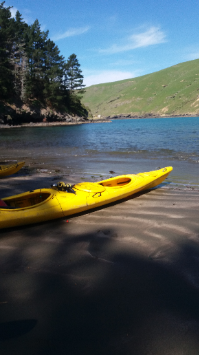 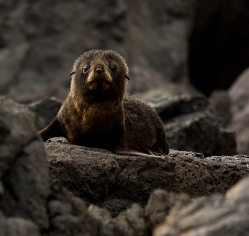 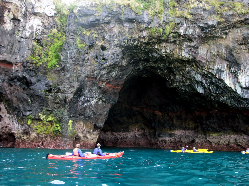 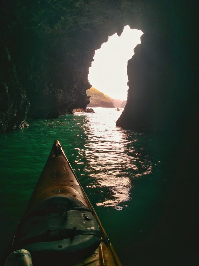 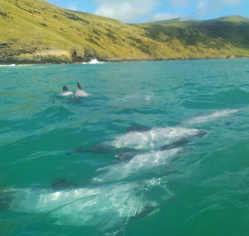  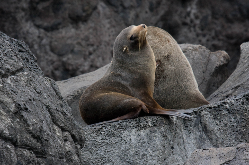 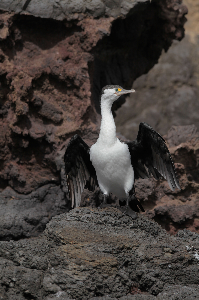 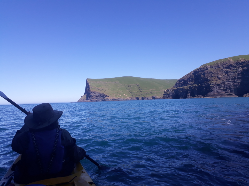 -661.jpg) 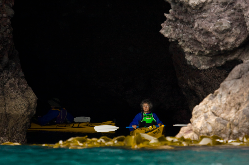 |
|
Ideally, we don’t want to handle our penguins at all. However, some of them need our help whether it be from an injury, illness or malnourishment. Pohatu Penguins steps in and gives these little birds a second chance at life! Most of our rehabilitated penguins are underweight or malnourished chicks. Typically, we find these chicks during our tours as we monitor the nesting sites. Why are the chicks malnourished/underweight?
What do you do in rehabilitation? This depends on the penguins needs and condition. Typically we will feed them 2-3 times a day depending on their weight and age. If they are old enough we will bring them for a swim in our “swim therapy pool”. Here, we introduce them to the water and determine if they are ready to be released. Injured or sick penguins will be sent to either a specialized penguin vet or dedicated specialists, Kristina and Thomas*, in Christchurch where they are assessed for future placement. Permanently injured penguins have the chance to live out their lives at the Antarctic Centre. *K&T Link: https://www.stuff.co.nz/environment/88518082/christchurch-couple-give-injured-rescue-penguins-the-full-pamper-treatment ParniaI spotted Parnia while kayaking; she was standing on the rocks looking extremely thin and weak. After getting back onto shore I quickly grabbed a bucket and went on to retrieve her – she gave little resistance to capture. Once I saw her up-close I realized that she had a deformed beak, probably why she had been so thin. (It’s very difficult for penguins to hunt efficiently with a crooked beak, most die.) I had never seen such a thin penguin and I expected her to die within the day, but still it was worth a shot to try and save her. Penguin band: P 41 087One year a starvation event happened right in the middle of the breeding season. When starvation occurs parents stop feeding their chicks to save themselves or only do so periodically. Chicks are then forced to leave (or fledge) the nest early in search of food. Unfortunately, chicks under 8 weeks old are not properly equipped to survive at sea and either starve or drown. In order to prevent early fledgings I fed the chicks while they remained in their burrows, hoping that the starvation event would end soon. Slowly but surely the parents started to return consistently feeding their youngsters and relieving me of my duties! Two years later P41 087 (we used to band our penguins) turned up in one of my breeding boxes. He was one of the largest, most beautiful penguins I had ever seen. P41 087 was evidence that my feedings, two years ago, had been a success. It warmed my heart to know that I helped save this little penguin and build him up for a healthy, successful life in the wild. He was my pride and joy. RoxyRoxy was handed in by the Fox II, a tourist sailing boat in Akaroa. She was extremely thin with a severe injury to her eye. Roxy looked like a recently fledged chick that seemed to have been hit by a boat. Her condition was very grim and I had my doubts about her survival.
However, to my delighted surprise she survived the first 24-hours, then the next and the next, and by day 3 she was on the road to recovery! Her eye injury, however, would be permanent and she would never be able to see from it again. Although, she was doing well in rehabilitation we knew that she wouldn’t stand a chance in the wild, thankfully, Roxy was also sent to the Antarctic Centre where she’ll live out a long and luxurious life! Shark baitThis is an all time favorite story that demonstrates incredible intelligence – intelligence you would never expect from a penguin. One night, while running an Evening Penguin Tour, we found a horribly injured penguin beside the track. I immediately took him into care and the next morning rushed him to Christchurch for an emergency veterinary assessment.. He had several shallow, flesh wounds and a lacerated leg. We suspected the culprit had been a shark. The vet stitched him up and I took him home to recover.. He spent a few weeks with us recovering and eating lots of fish – something he was quite happy to do through his moult*! Once his moult was complete we returned him to the sea and he happily shot off like a rocket! One year later, while running a tour, in the same spot on the tarck out in the open, we found a penguin near the track and out in the open we found a penguin that did move away from us as he should. He also did not attempt to bit and was very relaxed when I picked him up to examine him to find an explanation for this strange behaviour. He was in very good condition, but lame in one leg as Shark bait was when we released him. He proved beyond doubt who we was when I tried to feed him. He snapped and gulp the fish down gleefully and then looked for more, greedy as ever. As he was looking forward to another free easy loading molt we decided to indulged him and sent him on his way, fat and sleek once his feathers were grown in. Once again he shot off, instantly a wild penguin, but we did wonder, would he be back next year for another easy moult*? *Little Penguins moult – loose their old feathers and grow new ones – for two weeks every year. During the moult they cannot hunt and thus starve until it is complete. Yappy WiggleThis was the funniest penguin I’ve ever cared for! One day, while monitoring nesting sites I came across a burrow with one healthy chick and one very small runt. If one chick gets too far behind they simply die and the fouled nest can cause the healthy chick to become sick and die. The best option was to take the runty chick out, but then what to do with it? I decided I would simply throw it in the bushes. It’s very difficult to raise chicks that are less than 2 weeks old, especially if they are runts, but I thought I’d give it a go. Trying to feed such a young chick was not easy, but the little guy responded well and started to put on weight. Soon enough he turned into a healthy, respectable penguin. He became far too tame, however, and ran around like a puppy dog, wiggling his tail and begging for food with sharp, yapping noises. When it came time for him to leave he wasn’t exactly keen. On the first release he returned the next day yapping his way up the drive, begging for more fish. He had obviously not found any for himself. I allowed him to stay for a few days until I figured that we better try again; so, for a second time we released him back into the wild. He returned the very next day for more fish. I fed him once more and came up with a new idea, we’ll release him by kayak! So, in our third release, we took him by kayak to the entrance of Flea Bay and let him go. This seemed to be successful until the fifth day when we saw him hobbling towards the house. This time he was much weaker, thinner and a bit injured. I assumed he had hurt himself along the rocks and barnacles while exiting the sea. After our third try, we realized that Mr. Yappy Wiggle had imprinted on us and would not succeed in the wild. He now happily resides in the Antarctic Centre yapping and wiggling all over the place! Our Christmas Eve SagaBefore you read this you must understand: Yellow Eyed Penguins are the rarest penguin in the world and are extremely endangered. Every single one is precious. One Christmas Eve during a penguin tour we saw one of our Yellow Eyed Penguins drag itself ashore, obviously injured and bleeding. We caught the Yellow Eyed to gauge its injuries in which its feet were badly cut. It looked as though it kicked itself free from the jaws of life and escaped a near death shark attack. It needed stitching as soon as possible if it was to survive, but what vet would be open on Christmas Eve or Christmas Day? Talk about bad timing. I rang our closest vet in Little River and to my surprise he said to bring it straight over. This was 10.00pm on Christmas Eve. We arrived in Little River at 11.30pm, but the vet was nowhere to be seen. We sat there waiting and silently panicking over this precious penguin’s life. Until suddenly a vehicle pulls up with the vet and vet’s family! In order to successfully and painlessly stitch the penguin he needed to be put under. However, this can be dangerous if the penguin has a full stomach – something we weren’t sure about. We simply had to hope for the best and move forward with the procedure. The penguin did not fair well with the gas, he kept drifting in and out of conscious. Then, suddenly he started to heave and projectile vomit fish across the table, the floor and even the walls! Now, you can imagine our surprise, you can also imagine that it was quite unexpected and unfortunately we did not have time to react. So, like the table, the floor and the walls, we too were covered in fish vomit. Merry Christmas indeed! Thankfully after loosing its stomach contents our Yellow Eyed Penguin drifted into sleep and the vet was able to finish the job. With stitched and bandaged feet we placed our groggy penguin back into our vehicle. As we had to get the penguin home our vet and his family had to clean up the fish vomit – lucky them! We bid farewell and wished our Christmas heros a very Merry Christmas. After Christmas I sent the penguin to Christchurch to my wonderful friends and penguin rehab specialists, Christina and Thomas. Once it healed properly we released our Christmas penguin back into the wild. |
 Feeding chicks Feeding chicks Rehabilitated penguins in our garden going for a walk  Swim! (allow the penguins to oil up their feathers)  Releasing an adult.  Two chicks ready to go! (White flippered and Little Blue)  Trying to release Yappy Wiggle.  Still trying to release Yappy Wiggle...  Yellow Eyed Penguin with stitched foot.    |
|
These are just a few of the more memorable birds we have had in care. We rehabilitate many penguins, mostly Little Penguins, sometimes Yellow Eyed and occasionally a Crested Penguin. Most are sent off to sea successfully! If you too wish to help visit our Adopt a penguin page. |
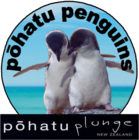

Comments